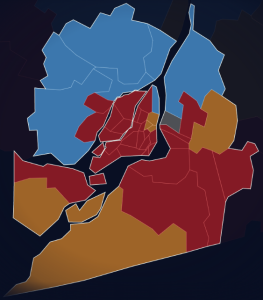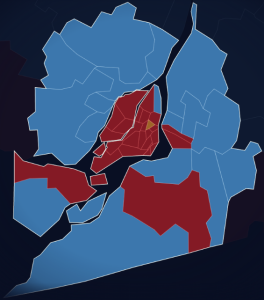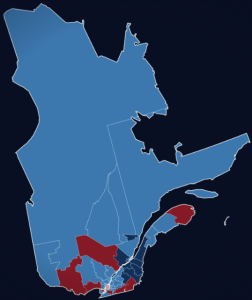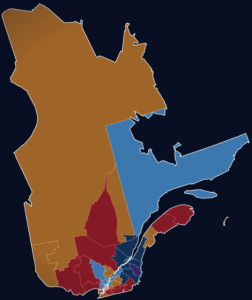What does the Renewed Bloc Québécois Mean for Canada?

By Shiv Ruparell
During his speech on election night, Bloc Québécois leader Yves-François Blanchet declared to an upbeat crowd at the historic Théâtre National in Montréal: “nous revenons de loin, mais nous irons encore plus loin,” roughly translated to “we were off the map, but we’re back, and we’re going to go even further.”
Just how far Blanchet can take his reinvigorated party remains to be seen. Blanchet has certainly earned the right to self-laudation, pointing out that in just one election the Bloc has sprung from political irrelevance to Canada’s third party, supplanting the New Democrats. Going into election day the Bloc had just 10 seats and was without official party status.
Under Blanchet, the Bloc took 32 seats in Québec, just three less than the Liberals and far more than the 10 seats that went Conservative and the one seat that went NDP. Notably, for a party whose support is typically strongest in rural and suburban ridings, the Bloc managed to steal a number of seats in and around Montréal from both the NDP and the Liberals.


‘New Kids on the Bloc’
While pundits have been quick to label the party’s resurgence as a broader cry for Québec sovereignty, Blanchet’s Bloc more closely resembles the provincial party of current Québec Premier François Legault of the Coalition Avenir Québec (CAQ), than it does the resolutely sovereigntist Bloc of Gilles Duceppe or Lucien Bouchard. While the Bloc’s platform still formally calls for the creation of an independent Québec state separate from Canada – which still has some real support within the province – the party has learned its lessons on focusing too squarely on referendums and separatism.
After being reduced to just 4 seats in the House of Commons in 2011, and undergoing a series of leadership turnovers and MP resignations, Blanchet and the Bloc appear to have come to the realization that sovereignty is not the only issue for Québec voters. The CAQ has shown that a nationalist and autonomist, but not necessarily separatist, party could sweep the province when they did so in last year’s provincial election. That sent the Bloc a clear message that autonomy within confederation was a priority to voters, particularly young voters, ahead of outright independence.
Despite the CAQ falling further ideologically right than the Bloc on most economic issues, Blanchet’s success can in large part be attributed to his ability to align the Bloc’s traditionally left-wing party to Premier Legault’s successful positioning. This has been particularly evident on identity issues, such as the province’s controversial Bill 21 which bans government employees from wearing religious symbols while at work. On this and other issues, Blanchet was able to appeal to Quebecker’s long-held emotional convictions in a way not seen since the referendum years.
The result is a strong Bloc voice in Ottawa that, while unlikely to be able to make good on most of its promises, will at the very least give this Liberal minority government headaches on topics such as Bill 21 and pipelines. The Bloc’s success will also give Premier Legault, who holds a substantial amount of influence on Québec issues, an opportunity to more concretely influence decision-making in Ottawa.


What to Watch for in the Bloc Platform
As is traditionally the case, much of the Bloc’s platform calls for unprecedented sovereignty in a range of jurisdictions, such as: allowing Québec to compete as its own team at the Olympics, giving Québec a veto on federal refugee decisions, and allowing the province to veto any federal projects on its soil such as pipelines. In other instances, the Bloc abandons jurisdictional independence and instead demands more money from Ottawa for things like increased federal health transfers and a renewed equalization program that targets resource-rich provinces such as Alberta and increases the amount of transfer that would be received by Québec.
However, looking beyond the glitzy proposals that appeal to the Bloc’s traditionally sovereigntist base, the party’s platform is unique. The Bloc’s platform, perhaps for the first time, offers policy proposals that might be realistically well-received in Ottawa and by other provinces. If the Bloc can exert its position in the minority parliament it runs a realistic chance of shaping Liberal policy in the areas like digital policy and the media, culture, environment and the economy, and even pharmaceuticals.
Digital Policy
On digital policy, the Bloc proposes (page 6) that Canada levy a 3% tax on web giants including Google, Apple, Facebook, Amazon, Microsoft, Spotify, and Netflix for any activity they conduct on Canadian soil. In addition, the party calls for the creation of a parliamentary group to examine how to best protect francophone culture online. Both proposals could be met with support from the NDP and from the Liberals’ Québec and New Brunswick caucuses.
Culture
On culture, the Bloc could receive multi-party support for a proposal to strike a parliamentary study, similar to the Lincoln Report, on how to best support online Canadian creators. It also supports federal financing for the controversial Université de l’Ontario Francais (page 9) which, despite a memorandum of understanding between the Province of Ontario and the Federal government, has been the subject of much uncertainty after a reversed funding cut by the Ontario government.
Environment and Economy
The greatest potential for agreement between the Bloc and the other federal parties lies with the party’s environmental and economic proposals. While calls for a “green equalization” program and an end to all pipelines are unlikely to gain much traction, Blanchet may find allies in Ottawa for proposals such the electrification of public transit, discounts on electric vehicles, increased funding for retrofitting buildings, and eliminating pesticides. On the economy, the NDP, Greens, and in some instances the Liberals, should open to Bloc proposals such as tougher rules on tax havens and including the Davie shipyard (page 38) as the third official partner in Canada’s National Shipbuilding Strategy.
Pharmacare
As the debate on national pharmacare program picks up, the Liberals will likely look to show progress in order to keep the support of the Bloc and the New Democrats. Reducing the price of pharmaceuticals for Canadians, including Quebeckers, is a key position in the Bloc’s platform. For instance, the Bloc’s proposal of removing the United States (page 20) from the reference list used to determine drug prices could easily be met with support in a more progressive parliament where the NDP holds significant sway. Any attempts to infringe on Québec’s healthcare jurisdiction, however, will be met with significant backlash.
In Conclusion
Ultimately, the Bloc Québécois will play a moderate role in Canada’s 43rd parliament. Though the party is not calling for an immediate referendum on independence for the first time in recent memory, there is still a stigma around other federal parties formally joining forces with a separatist party. Canadian voters were irked by a Liberal-NDP-Bloc coalition in 2008 and appearing to repeat that is fraught with risk. Nonetheless, while the Bloc will not be included in any formal arrangement, in a hung parliament where every vote counts, its ability to lend support to key legislation will make the Bloc not just interesting to watch, but strategically important.